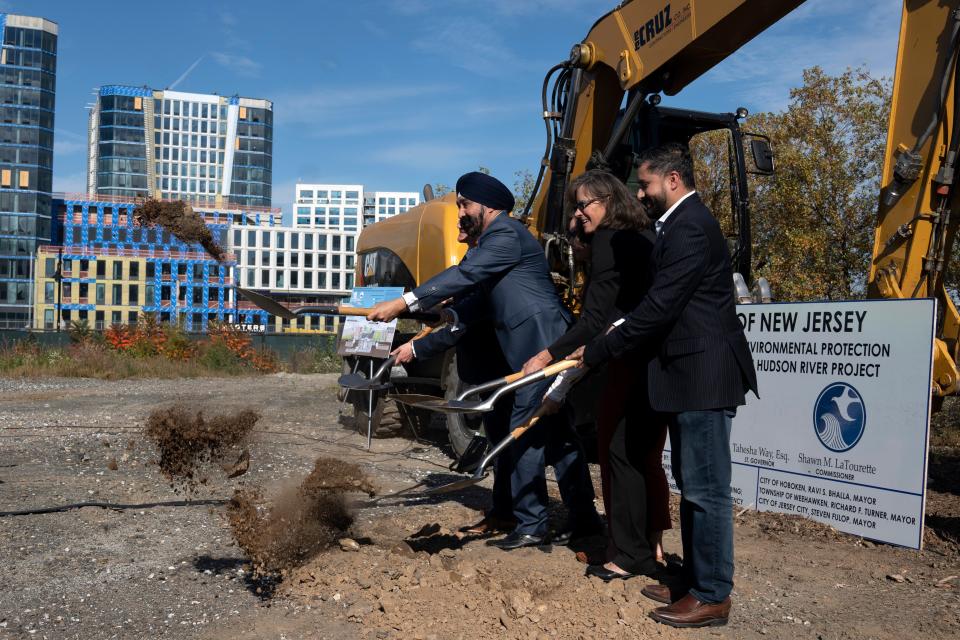$52B plan to reduce Meadowlands and NYC flooding addresses just storm surge, critics say
A coalition of environmental experts and elected officials have joined forces to demand a more holistic flood protection plan for New York City and North Jersey than the $52 billion plan that the Army Corps of Engineers has proposed so far.
A bipartisan group of 12 lawmakers from both states signed a letter arguing that the Army Corps plan focuses only on preventing storm surge, such as was caused by Superstorm Sandy, and not on how to address the chronic flooding the region now experiences because of sea level rise and more frequent intense rainstorms exacerbated by climate change.
New Jersey Rep. Donald Payne Jr. signed the letter, along with a number of New York City representatives, including House Minority Leader Hakeem Jeffries and Rep. Alexandria Ocasio-Cortez.
They say the corps proposal does not comply with the Water Resources Development Act, issued in 2020 and 2022. The act, which Congress updates every two years, authorizes Army Corps studies, projects and programs about flood and coastal storm risk management across the U.S.
Huge floodgate would span the Hackensack River
The corps began creating plans to protect New York Harbor and North Jersey Meadowlands communities seven years ago. Its current ideas primarily suggest building storm surge barriers — structures in the water with gates that can close when a hurricane or large swell comes in.
A floodgate longer than five football fields would span the Hackensack River to prevent a tidal surge from inundating Meadowlands communities. The 1,900-foot gate and a series of flood walls and berms along the Hackensack and Passaic rivers are part of the $52 billion proposal.

The plan has also drawn criticism from environmental groups and local officials who say building hard infrastructure will just push a storm surge to other communities along the river.
Congress has not yet allocated any funds to the project, which has been in the works for years. It calls for the states or local communities to pay for 35% of the overall cost. Construction would begin in 2030 and end in 2044, according to the 569-page plan released a year ago.
The plan is a scaled-down version of a $119 billion option to build a 5-mile barrier between Sandy Hook and New York that was unveiled in 2018 and drew criticism from many, including then-President Donald Trump, who mocked it on Twitter.
The floodgate on the Hackensack would span Secaucus and Kearny from north to south at a sharp bend in the river, according to a map in the plan. It would protect Secaucus, Kearny, Lyndhurst and other areas upriver, the report says. It would have a 100-foot-wide navigable passage.
The Army Corps of Engineers plan also calls for several shoreline barriers along the lower Hackensack and Passaic rivers in Bergen, Essex and Hudson counties.
In New York, the plan also includes building movable sea gates across several waterways, including the Flushing and Newtown creeks, Jamaica Bay, the Gowanus Canal and the Arthur Kill and Kill Van Kull between Staten Island and New Jersey.
More: Remember Sandy? $300M flood resiliency projects break ground in Meadowlands and Hoboken
More: A decade after Sandy, devastated Meadowlands towns still adding defenses, still vulnerable
Over the past few years, residents in New Jersey and New York have experienced severe impacts from flooding, including mass disruptions to public transit and destruction of property during major storms such as Ida.

Some areas, such as Hoboken, have announced major projects in response that involve pump construction and infrastructure updates to curb future flooding's worst outcomes.
Preservation experts believe the Army Corps plan’s single-hazard approach is “shortsighted,” lacks accurate science and contains outdated cost-benefit analyses.
Rain-related flooding from intense storms
Rising sea levels and rain-related flooding from more intense and frequent storms are causing the most suffering in the region’s communities, said Hudson Riverkeeper President Tracy Brown. Riverkeeper protects the Hudson River and clean drinking water in New York.
“In a humane world, the plan isn’t [to] wait until there’s a disaster and there’s a hole in the back of their house or they’re underwater, but plan ahead,” Brown said.
More: Army Corps picks $52B floodgate plan to protect Meadowlands from Sandy-like storm surges
More: NJ flooding is getting worse. Saturation Point series traces impact, inspects solutions
The corps “hasn’t looked at the context … that is critical for any kind of study and plan for dealing with flooding” by excluding rainfall, tidal flooding over time and sea level rise projects, agreed Kate Boicourt, the director of the Environmental Defense Fund’s NY-NJ Climate Resilient Coasts and Watersheds program.
Boicourt and Brown worry about the effects the corps' proposal could have on communities in the region. Public engagement in the planning process has been “insufficient,” Boicourt said, and left out some key communities, particularly low-income areas.
Use nature-based systems to help
Brown wants to see a “layered approach” that involves considering several strategies, starting with using nature and nature-based systems, such as “protecting living shorelines and the living river systems” that “naturally break wave energy and provides extra flooding capacity in our communities.”

The experts want to see a “more integrated and collaborative approach between the federal government and our local governments,” Brown said.
Successful projects the experts cited include floodable parks on the east side of Brooklyn and raised streets in some areas of New Jersey.
According to an Army Corps of Engineers update from September, the corps is reviewing public comments and considering how to move forward to complete its study. The Agency Decision Milestone that was expected this summer was delayed until later in the fall.
This article originally appeared on NorthJersey.com: NJ, NY officials criticize Meadowlands flood protection plan

